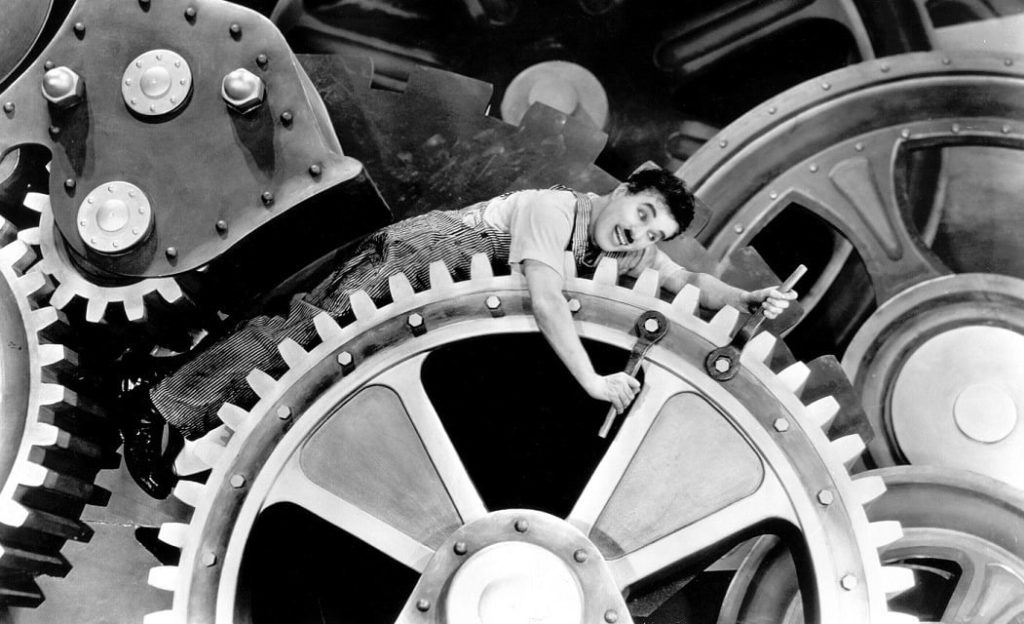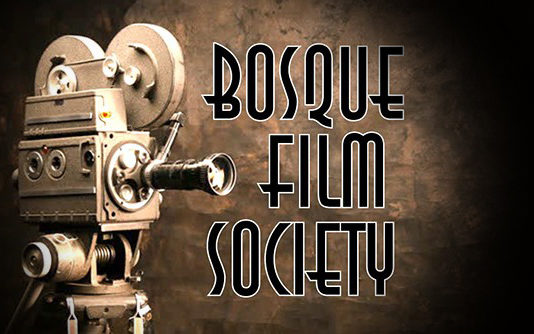Taking a look back at Charlie Chaplin’s film “Modern Times”
presented by WILLIAM GODBY
Bosque Film Society Filmmaker in Residence
This article is from Garrison Keillor’s The Writer’s Almanac for Friday, February 5, 2021
On this date in 1936, Charlie Chaplin‘s film “Modern Times” opened in New York City (works by Chaplin). It was the last film in which his beloved and iconic character “the Little Tramp” appeared, and it was the only film to include the Tramp’s voice.
 “Talkies” had been around since The Jazz Singer in 1927, but Chaplin had held out. His films had been internationally successful in large part because there was no language barrier in silent films; his comedy was physical, and it was a simple matter to replace English title cards with those in the local language. Chaplin knew that giving the Tramp dialogue meant losing all the audiences that didn’t speak English.
“Talkies” had been around since The Jazz Singer in 1927, but Chaplin had held out. His films had been internationally successful in large part because there was no language barrier in silent films; his comedy was physical, and it was a simple matter to replace English title cards with those in the local language. Chaplin knew that giving the Tramp dialogue meant losing all the audiences that didn’t speak English.
In 1931, he had released “City Lights,” which was silent in defiance of the new mania for sound, and had gone so far as to say that talking pictures were a fad that wouldn’t last. He told an interviewer, “Dialogue may or may not have a place in comedy … dialogue does not have a place in the sort of comedies I make.” The interviewer asked him if he had ever tried including dialogue, and he answered, “I never tried jumping off the monument in Trafalgar Square, but I have a definite idea that it would be unhealthful.”
“City Lights” was a critical and commercial success, and one reviewer said,”Nobody in the world but Charlie Chaplin could have done it. He is the only person that has that peculiar something called ‘audience appeal’ in sufficient quality to defy the popular penchant for movies that talk.”
By 1934, however, Chaplin had realized that the days of the silent movie had passed, and he was worried about being seen as old fashioned and outdated. He wrote a dialogue script for “Modern Times,” but in the end, used almost none of it. He used sound effects, and human voices carried through radios and loudspeakers, but the Little Tramp did not speak. He did, however, sing: at one point in the story, he gets a job as a singing waiter, but loses the lyrics to the song he’s meant to sing. He sings a language of gibberish instead — no translation required.
“Modern Times” reflects the anxieties of its age. Chaplin had spent the past year and a half touring Europe, witnessing the rise of nationalism and the effects of the Great Depression. He describes how he got the idea for the film:
“I was riding in my car one day and saw a mass of people coming out of a factory, punching time clocks, and was overwhelmed with the knowledge that the theme note of modern times is mass production. I wondered what would happen to the progress of the mechanical age if one person decided to act like a bull in a china shop.”
The movie portrays a very different reality from the pre-World-War-I world into which the Little Tramp character was born. Workers were being replaced by machines, and — even worse — assembly-line labor was turning them into machines themselves. Humanity was second to progress and efficiency, and Chaplin turned anxiety into comedy.
When the movie opens, the Little Tramp is working in a factory, but his mindless and repetitive task — which he must perform faster and faster to satisfy the foreman — drives him mad and he literally becomes a cog in the great machine of industry. He spends the rest of the movie in a series of jobs, and tries to get arrested so he can have three meals a day and a place to sleep.
Eventually, he finds happiness in an anarchist lifestyle with his co-star, Paulette Goddard, who plays “the Gamine.” They walk off into the sunset to the strains of the song “Smile,” which was composed by Chaplin.
